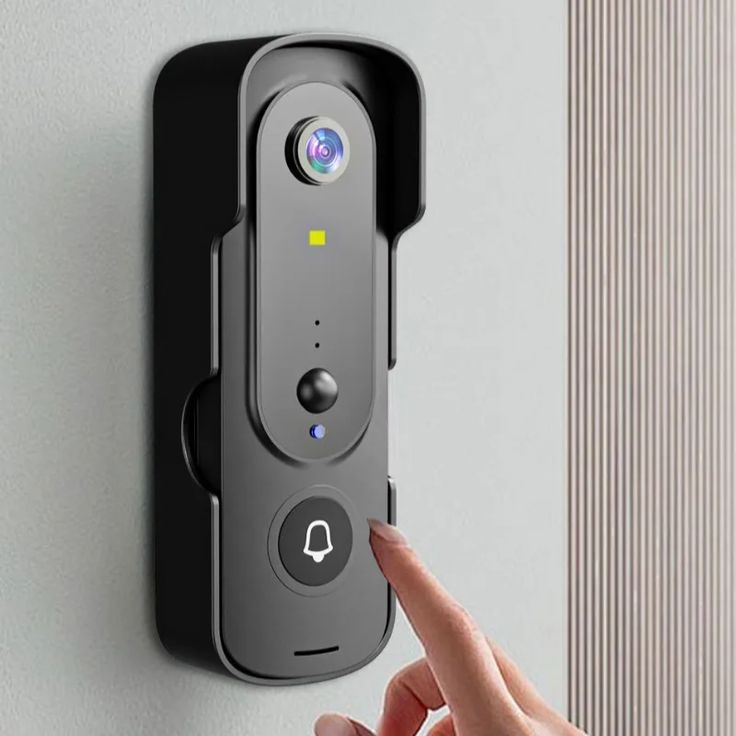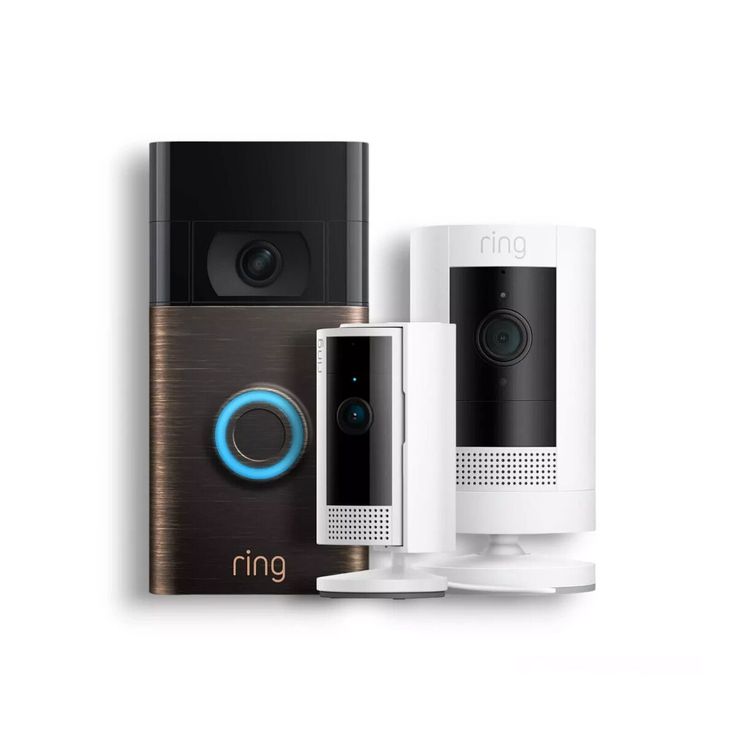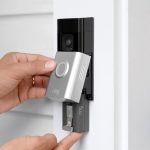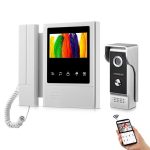What Are Doorbell Cameras?
Doorbell cameras are innovative home security devices that capture video at your front door. They link to your Wi-Fi, enabling remote access through smartphones or other devices. When someone approaches your door, these cameras send alerts and can record video footage. Some models also allow you to speak with visitors using two-way audio. How do doorbell cameras work? Essentially, doorbell cameras offer surveillance, communication, and convenience. They help you see and interact with visitors, deter potential thieves, and monitor doorstep deliveries. Easy to install, they often come as wired or wireless systems compatible with smart homes. These gadgets are an integral part of modern home security, enhancing safety and providing peace of mind.

Key Features of Doorbell Cameras
Doorbell cameras integrate several features that bolster home safety and communication. First and foremost, Wi-Fi connectivity is crucial. This allows the camera to send live footage or alerts to your connected device. Whether you’re at home or away, you can see who’s at your door in real time.
Another significant feature of these devices is motion detection. Cameras start recording when they detect motion near your front door. This keeps you informed about all doorstep activities without continuous recording.
Moreover, two-way audio is an essential feature that allows you to communicate directly with whoever is outside. Whether it’s a delivery person or an unexpected visitor, you can speak with them right through your smartphone.
In summary, doorbell cameras offer three main features: Wi-Fi connectivity for remote monitoring, motion detection for intelligent alerts, and two-way audio for convenient communication. These capabilities make doorbell cameras an integral component of modern home security systems, enhancing safety and adding convenience.
How Doorbell Cameras Work
Integration with Wi-Fi Networks
Doorbell cameras connect to your home’s Wi-Fi. They stream video to your devices, keeping you connected.
Motion Detection and Recording
When motion is sensed, doorbell cameras record. You get alerts and videos of doorstep activity.
Two-Way Audio Communication
Speak to visitors from anywhere using your smartphone. Two-way audio makes this possible and simple.

Benefits of Installing a Doorbell Camera
The advantages of adding a doorbell camera to your home are numerous. Let’s delve into some of the primary benefits.
Security and Deterrence
Firstly, a doorbell camera provides increased security. It can deter burglars and porch pirates who notice the camera. Also, the real-time monitoring alerts homeowners to suspicious activity instantly.
Convenience and Remote Access
Secondly, convenience is a key benefit. With a doorbell camera, you can talk to visitors from anywhere. This is useful if you’re away or unable to come to the door.
Evidence Collection
Finally, doorbell cameras assist in evidence collection. They store footage that can help identify criminals. This footage can be vital for police reports or insurance claims.
In conclusion, the benefits of doorbell cameras extend beyond basic security. They offer added convenience and crucial evidence, making them invaluable for modern home security.
Choosing the Right Doorbell Camera for Your Home
Choosing the right doorbell camera is essential for maximizing security and convenience. Here are key factors to consider when selecting a doorbell camera for your home:
Video Resolution and Field of View
The clarity of your video is crucial. Look for at least 1080p video resolution. A wide field of view, around 120 to 180 degrees, is best. This allows you to see more area around your doorstep.
Installation Types: Wired vs. Wireless
Decide whether a wired or wireless doorbell camera suits your home. Wired cameras require a connection to your home’s electrical system. Wireless cameras are easier to install and offer more flexibility in placement.
Smart Home Compatibility
Check if the camera works with other smart devices you own. Compatibility with systems like Alexa or Google Home adds convenience. You can control everything with voice commands or a single app.
Storage Options for Footage
You’ll need to store footage for viewing later. Some doorbell cameras offer cloud storage, while others have local storage. Cloud storage often requires a monthly subscription. Decide what works best for your needs and budget.
These factors help ensure you select a doorbell camera that fits your requirements. High-resolution video and broad viewing angles enhance security. Installation type impacts the ease of setup. Smart home compatibility provides ease of use. Finally, storage options determine how you access recordings. Keep these in mind when shopping for your new doorbell camera.

Steps to Install a Doorbell Camera
Installing a doorbell camera is fairly straightforward. Follow these steps to add this security feature to your home.
Choose the Right Location
Pick a spot near your front door with a good view of your entranceway. Ensure it’s within range of your Wi-Fi network for optimal connectivity.
Install the Mounting Bracket
Secure the mounting bracket that came with your camera to the wall. Most brackets will require you to drill holes and use provided screws.
Set Up the Camera
Attach your doorbell camera to the mounting bracket. Make sure it snaps firmly into place and is stable.
Connect to Power
For wired cameras, connect to existing doorbell wires. For wireless models, insert batteries or connect to a power source.
Sync with Wi-Fi
Use the camera’s app to connect it to your home’s Wi-Fi network. Follow the in-app instructions to complete the setup.
Test the Camera
Ring the doorbell to check the camera’s function. Make sure you can see and hear clearly through your device.
By following these steps, you can install a doorbell camera yourself. Most models also come with detailed instructions specific to the device, ensuring an easy setup process.
Potential Drawbacks of Doorbell Cameras
As with all technologies, doorbell cameras come with their own set of potential drawbacks. Being aware of these can help you make an informed decision and address any concerns proactively.
Weather Resistance and Theft Prevention
Doorbell cameras are exposed to the elements, so it’s important to choose models with good weather resistance. Look for devices rated for the climate you live in. Additionally, these cameras can be targets for theft. Opt for devices with theft-deterrent features or consider added measures to secure the device.
Dependence on Wi-Fi and Risks of Hacking
These cameras rely heavily on Wi-Fi, and if your network is down or unstable, your camera’s functionality may be compromised. There’s also a risk of hacking, as with any connected device. Secure your network with strong passwords and regular updates to reduce the risk.
Subscription Services and Feature Accessibility
Some doorbell cameras require a subscription service for full functionality. This can include storage for video footage. Without a subscription, you may only have access to live viewing with limited recording. Be sure to check what features are available with and without a subscription before purchasing.
Being mindful of these potential issues can help you ensure that your doorbell camera serves its intended purpose without unexpected complications. Always weigh these factors alongside the benefits to make the best choice for your home security needs.
Frequently Asked Questions about Doorbell Cameras
data>
When it comes to adding a doorbell camera to your home, several common questions arise. Below, we address some of the most frequently asked questions about how doorbell cameras work.
Recording Duration and Video Range
Doorbell cameras generally record when they detect motion. The recording duration is limited to the event itself to conserve storage. The video range often spans from 155 to 180 degrees, allowing a broad view of your doorstep and surroundings. Higher-end models might offer a wider range or enhanced detection capabilities.
Installation Requirements
Most doorbell cameras require a Wi-Fi connection and a power source like existing doorbell wiring or a battery. The installation process typically involves mounting the camera, connecting to power, and syncing with your Wi-Fi. Consult the manual for specific instructions or hire a professional if unsure.
Subscription Services for Enhanced Features
While basic functionality of doorbell cameras is usually available without extra costs, many offer subscription services for advanced features. These can include additional video storage, professional monitoring, and more. Always compare the features included with and without subscriptions when choosing your device.

